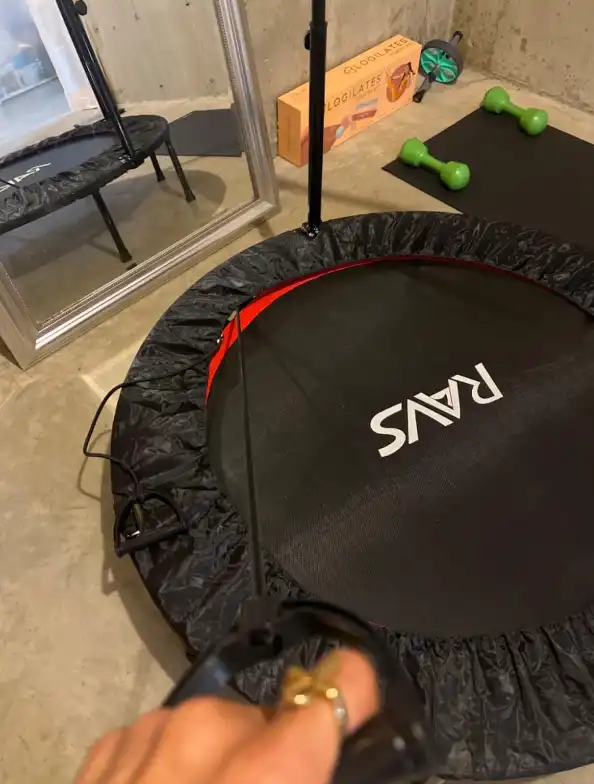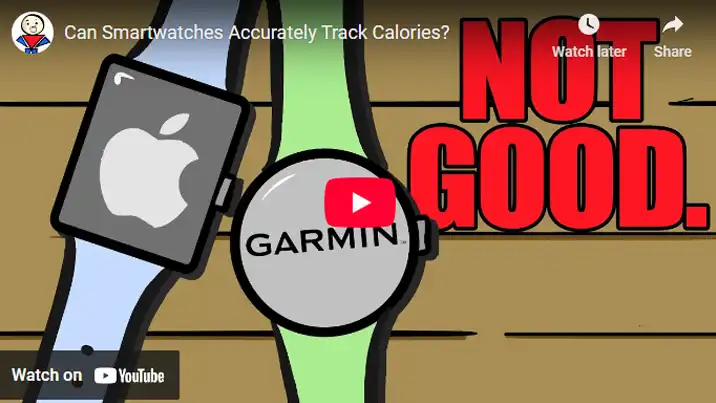Answered: How Many Calories Does Jumping on a Trampoline Burn?
Disclaimer: This website exists thanks to you, the readers. When you buy through links on my site, I may earn an affiliate commission.
So, you’re thinking of buying a mini trampoline (or you already have one) and you want to know: How many calories does jumping on a trampoline burn?
The short answer is “a lot”! To know how many you will burn, as an individual, scroll down a bit because the exact number isn’t the same for everyone.
In any case, as someone who rebounds almost daily and has reviewed a ton of trampolines, I can tell you it’s 100% worth it because it’s effective and SO much fun 😊
Key Takeaways
- Moderate-intensity jumping on a mini trampoline is as effective as jogging (and sometimes more) while being gentle to your joints.
- It also burns roughly the same amount of calories as medium-speed bicycling.
- High-intensity trampoline moves burn at least 20% more calories than basic bouncing.
- Heavier individuals naturally burn more calories, but lighter people can compensate by increasing intensity.
How many calories does jumping on a trampoline burn?
Based on an American Council on Exercise (ACE) study, participants burned an average of 12.4 calories per minute in men and 9.4 kcal/min in women. This equates to about 706.8 calories per hour for men and 564 calories per hour for women. Your exact calorie burn depends on your weight, workout intensity, workout duration, type of trampoline, and personal metabolic factors.
Rebounding Calories Burned Calculator
Enter your weight in pounds (lbs) and the duration of your workout to find out how many calories you will burn.
Tracking your calories while you're training
I use my Cellerciser®, along with this calorie burning monitor and it works perfectly well for me. Simple and easy.
A second option is to use your fitness tracker or smartwatch. Unfortunately, there isn’t yet a smartwatch that has a rebounding setting. So, the best you can do is, for example, use “Other” on Apple Watch or “Workout” on Fitbit. Don’t sweat too much over choosing the right setting. Smartwatches aren’t that smart anyway.
How many calories do you burn jumping on a trampoline for 30 minutes vs. other sports?
Recreational trampoline jumping offers an effective way to burn calories while having fun. Here's a breakdown of the ACE study, along with more information about calories burned during different types of activities, according to Harvard.
Activity | 125 lbs (56.7 kg) | 150 lbs (68.0 kg) | 185 lbs (83.9 kg) |
|---|---|---|---|
Trampoline Jumping (Moderate intensity) | 229 | 175 | 339 |
Running (5 mph) | 240 | 288 | 336 |
Aerobics (low impact) | 165 | 198 | 231 |
Bicycling (12-13.9 mph) | 240 | 288 | 336 |
Swimming (general) | 180 | 216 | 252 |
The formula
If you really want to get geeky, let’s do the math.
The basic formula to calculate calories burned during trampoline exercise uses MET values and body weight. MET stands for Metabolic Equivalent Task — a measure of exercise intensity. This will give you an answer to the question “How many calories does jumping on a trampoline burn per minute?”
(MET x Body weight in Kg x 3.5) / 200 = Calories burned per minute
MET is 7.7 for moderate to intense trampolining. Let’s put this into context.
Example: Calculating calories burned on a mini trampoline
- Turn your body weight into kg: Weight in lbs x 0.45, e.g. 125 x 0.45 = 56kg
- (MET x body weight in Kg x 3.5) / 200, e.g. (7.7 x 56 x 3.5) / 200 = 7.6 calories per minute for a 125 lbs person.
- Calories burned per minute x Minutes trained, e.g. 6.37 x 30 = 226 kcal burned
If you weigh 125 lbs, or approximately 56 kg, you are likely to burn 191 kcal during a 30-minute moderate to intense rebounding session.
Factors that affect calorie burn on a trampoline
Many things change how many calories you burn on a trampoline. The exact number varies based on several factors.
1. Body weight
Heavier people tend to burn more calories because their bodies need more energy to move. Think of it like this: If you carry a heavy backpack while jumping, you’ll get tired faster. Your body has to work harder to push off the trampoline and land, so you burn more calories than someone lighter.
Example with vigorous trampoline jumping
- A 125-pound (56.7 kg) person burns about 230 calories in 30 minutes.
- A 185-pound (83.9 kg) person burns about 339 calories in 30 minutes.
💡 Tip: If you're lighter but want to burn more calories, increase workout intensity to make up for lower body weight.
2. Jumping intensity
The harder you jump, the more energy your body uses. A slow, gentle bounce won’t burn as many calories as fast, high-energy movements.
I boost my calorie burn by mixing high and low-intensity moves on the trampoline. A fast-paced trampoline workout at high intensity means 20% more calories burned on your mini trampoline than steady bouncing.
Example for a 185 lbs person
- Light bouncing (feet barely leaving the mat): 5–8 calories per minute
- Moderate jumps (higher jumps with control): 10–12 calories per minute
- High-intensity (tuck jumps, sprinting in place): 12–14+ calories per minute
💡 Tip: Try mixing slow, controlled jumps with fast, powerful moves to keep your heart rate up and burn more calories without overexerting yourself.
3. Workout duration
The longer you jump, the bigger your calorie burn. It stays steady as long as you keep up the same pace.
A longer workout means great weight loss results, but it might not be for everyone. Short 10-minute sessions work great for beginners to build stamina.
Whatever you do, don’t get discouraged by the numbers! I know how frustrating it is when you remember that eating a few blocks of chocolate means exercising 30 minutes just to burn those few extra calories. But the important thing is to prioritize trampolining (or any other sport) and be consistent.
It’s not just about calories. You’re working to keep your body healthy so it serves you longer and better!
Example for a 185 lbs person, moderate jumping
- 10 minutes: about 113 calories
- 30 minutes: about 339 calories
- 60 minutes: about 678 calories
💡 Tip: If you’re short on time, do interval training—30 seconds of intense jumps, then 10-15 seconds of rest. It burns more calories in less time.
4. Type of Movements
Not all trampoline moves burn the same amount of calories. Some engage more muscles and make your body work harder.
Example
✔ Basic bouncing – Easy on the body, burns fewer calories.
✔ Jumping jacks – Uses arms and legs, burns more calories.
✔ Knee lifts (high knees) – Engages your core, burns more fat.
✔ Twist jumps – Works your abs and side muscles.
✔ Sprinting in place – Mimics running, burns a ton of calories.
✔ Tuck jumps – Super high-intensity, spikes heart rate fast.
💡 Tip: Add arm movements (like raising your hands up and down) while jumping. The more muscles you use, the more calories you burn!
Here is an example trampoline workout routine:
5. Health conditions
Some medical conditions can affect how many calories your body burns. For example, Hashimoto’s, an autoimmune condition that affects the thyroid, can slow down metabolism, making it harder to burn calories efficiently.
💡 Tip: If you have a condition that affects metabolism, focus on higher-intensity movements or increase workout duration to maximize calorie burn. Don’t forget to consult your healthcare provider for guidance.
Tips to increase calorie burn while jumping on a trampoline
Mix up your moves
Straight jumps burn calories, but mixing up moves boosts the burn rate even more. Star jumps, swivel hips, tuck jumps, and seat drops target different muscle groups and keep your heart rate up.
My trampoline routine includes 30 seconds of each move before switching to the next one. I also do a 15-second light movement in-between exercises to be able to catch my breath without losing momentum. This burns more calories than basic bouncing.
Example HIIT trampoline workout round
- 30 seconds: Sprint in place.
- 15 seconds: Rest (light bouncing).
- 30 seconds: Tuck jumps.
- 15 seconds: Rest.
- 30 seconds: Jumping jacks.
- 15 seconds: Rest.
- 30 seconds: High knees.
- 15 seconds: Rest.
- 30 seconds: Twist jumps.
- 15 seconds: Rest.
💡 Tip: Repeat this circuit 5-6 times for a killer cardio session! 🔥
Engage your upper body
Most people only use their legs when jumping, but involving your arms and upper body helps you burn even more calories.
Ways to engage your upper body
✅ Move your arms while jumping (pump them up and down).
✅ Hold light dumbbells (1–3 lbs) and do bicep curls or shoulder presses while bouncing.
✅ Use wrist weights to engage your arms.
✅ Use arm resistance bands like the ones below. This photo is from the RAVS mini trampoline which comes with resistance bands but you can also buy them separately. For example, the ALTA 'Never-Snap' Exercise Bands are a nice choice.

Add resistance for more challenge
Want to take your trampoline workout to the next level? Add extra resistance to make your muscles work harder.
Ways to add resistance
✅ Wear ankle weights (start light—1–2 lbs per leg).
✅ Wear resistance bands around your thighs. I use these woven resistance bands. They are better quality and don’t slip like the rubber ones.
💡 Tip: More resistance = more effort = more calories burned! But start light to avoid strain. This is not recommended if you are a beginner!
Trampolining benefits go beyond burning calories
- Improves heart health – Strengthens the cardiovascular system and boosts endurance.
- Low impact on joints – Softer landings reduce strain on knees and ankles compared to running.
- Enhances balance & coordination – Engages stabilizing muscles for better body control.
- Boosts lymphatic drainage – Helps remove toxins and supports the immune system.
- Strengthens muscles – Works the core, legs, and glutes with every jump.
- Increases bone density – Weight-bearing movement supports bone health.
- Improves mental health – Releases endorphins, reducing stress and anxiety.
- Supports digestion – Gentle bouncing stimulates gut movement and digestion.
- Increases flexibility – Promotes better joint mobility and muscle elasticity.
- Fun & engaging – Keeps workouts enjoyable and sustainable for long-term fitness.
Conclusion
So how many calories does jumping on a trampoline burn?
Trampolining is a fun way to burn calories. It’s also great for your heart, balance, and joints. The number of calories you burn depends on your weight, intensity, and how long you jump. Add new moves, jump higher, and try intervals to boost your results.
Regular trampoline workouts boost heart health, balance, and bone strength while putting less stress on joints than other exercises.
The best part? It never feels like a workout! Keep bouncing, stay consistent, and enjoy the benefits.💪😊
FAQ
How many calories do you burn in 30 minutes on a trampoline?
The number of calories burned depends on your weight and workout intensity. Based on the ACE study, a 150-pound (68 kg) person burns about 275 calories in 30 minutes of moderate-intensity trampolining. If you increase intensity with high-energy moves, you can burn over 330 calories in the same time.
Example estimates for 30 minutes moderate intensity:
- 125 lbs (57 kg): about 229 calories
- 150 lbs (68 kg): about 275 calories
- 185 lbs (84 kg): about 339 calories
What is 10 minutes on a trampoline equivalent to?
10 minutes of trampoline jumping is often compared to 30 minutes of jogging in terms of cardiovascular benefits and calorie burn. A study by NASA found that rebounding is 68% more effective than running for cardio endurance.
However, like I said before, it’s not a simple comparison. There are a lot of factors like “How much do you weigh?” and “How fast is jogging for you?”, and so on.
Estimated calorie burn in 10 minutes (moderate intensity trampolining):
- 125 lbs (57 kg): about 76 calories
- 150 lbs (68 kg): about 92 calories
- 185 lbs (84 kg): about 113 calories
Is jumping on a trampoline good for weight loss?
Yes! Jumping on a trampoline is a great way to lose weight because it’s high-energy, low-impact, and fun. A 30–60 minute trampoline workout burns calories similar to running or cycling. Plus, trampolining boosts metabolism, strengthens muscles, and improves cardiovascular fitness—all key for fat loss.
Why it works for weight loss:
- Burns 500–700+ calories per hour
- Engages multiple muscle groups
- Less stress on joints than running
- Helps build muscle and balance, which supports long-term fat loss.
Does trampolining help burn belly fat specifically?
Unfortunately, no. 😔 Trampolining burns overall body fat, but spot reduction just isn’t possible. It’s not possible with any type of exercise. However, combining rebounding with core-focused moves (like tuck jumps or twists) can strengthen your abs while burning calories. You can do a lot of core work on a trampoline.
Can trampoline workouts replace cardio exercises like running?
Yes! Trampoline workouts provide similar cardiovascular benefits while having a lower impact on the joints. Plus, high-intensity trampolining burns calories comparable to running at moderate speeds.
How many calories does trampolining burn per hour?
The number of calories burned per hour depends on your weight and workout intensity. Based on the ACE study, a 150-pound (68 kg) person burns about 550 calories per hour doing moderate-intensity trampoline exercise. Higher-intensity jumping can burn 650+ calories per hour.
Estimated calorie burn per hour at moderate intensity:
- 125 lbs (57 kg): about 458 calories
- 150 lbs (68 kg): about 550 calories
- 185 lbs (84 kg): about 678 calories
How much weight can you lose jumping on a trampoline?
Weight loss depends on how many calories you burn vs. how many you consume. To lose 1 pound (0.45 kg) of fat, you need to burn about 3,500 more calories than you eat.
Here is what happens when you combine trampolining with diet. In 1 hour of moderate trampolining, you can burn 500–700 calories. If you maintain a 500-calorie deficit per day (from exercise + eating slightly less), you can lose up to 1 pound every week! That’s up to 4 pounds or 1.8 kg per month.
Here are some exercise options:
Option 1: High-Intensity (fastest fat loss)
- 30–45 min, 3–4x per week
- Mix high jumps, sprinting, and HIIT-style moves
- Burns 300–600 calories per session
Option 2: Moderate Workouts (steady weight loss)
- 30 min, 4–5x per week
- Moderate bouncing, mix of strength & cardio moves
- Burns 200–400 calories per session
Option 3: Short but Frequent (easiest to stick with)
- 10–20 min, 5–6x per week
- Simple but steady bouncing, fun workouts
- Burns 100–250 calories per session
References & Further Reading
- Burandt P, Porcari JP, Cress ML, Doberstein S, Foster C. Putting Mini-Trampolines to the Test. ACE Prosource. 2016: 1–3.
- L. Cugusi, A. Manca, G. Romita, M. Bergamin, A. Di Blasio, G. Mercuro, Exercise intensity and energy expenditure during a mini-trampoline rebounding exercise session, Science & Sports, 2017
- Aalizadeh B, Mohammadzadeh H, Khazani A, Dadras A. Effect of a Trampoline Exercise on the Anthropometric Measures and Motor Performance of Adolescent Students. Int J Prev Med. 2016
- Tomassoni, T. L., Blanchard, M. S., & Goldfarb, A. H., Effects of a Rebound Exercise Training Program on Aerobic Capacity and Body Composition
- How to Jump on a Trampoline: Safety Tips and Rules
- My Honest Review of the Cellerciser after 3 Years
- What Size Rebounder Do I Need? The Easy Guide.
- Checklist: What to Look for When Buying a Rebounder?
- The Best Mini Trampolines for Lymphatic Drainage: Reviewed and Tested


